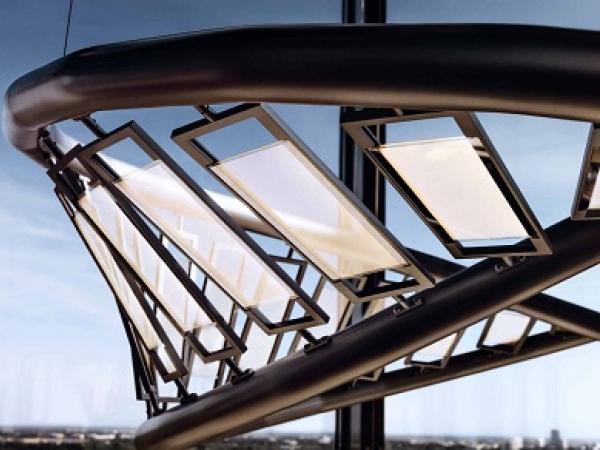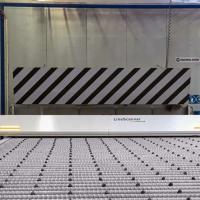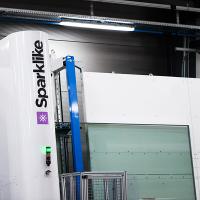Even today, glass panes can be transformed at the press of a button, upscaled to radiant media glazing or – in wafer-thin versions – be used as high-performance displays.
Glass products are used for more applications than ever before and their performance range is growing constantly. Ever new applications require the optimisation of existing, and development of ever new, special glass types with specific functionalities. The unique transparency of this material continues to be a paramount criterion but the versatile applications are today determined by the add-on functions achieved by specific manufacturing and finishing technologies.
Photo 1 - Individualised media façades can be realised by incorporating LEDs in glass laminates. This photo shoes an application where the “powerglass” product by German producer glas platz gmbh & co.kg was used. Photo: PopSign
A wide variety of functional glass has stood the test of time in windows and façades for decades already and over the past ten years, in particular, glass products have virtually boomed in interior design thanks to the very successful development efforts undertaken by glass companies and glass machine manufacturers. Highly developed manufacturing and finishing techniques make for high-performance functional glass with properties that are precisely tailored to customer needs for both exterior and interior use.
For building skin applications performance characteristics like thermal insulation, solar protection, sound proofness and security are in the foreground. Thanks to the use of innovative coating and lamination technologies the products in this market segment push the limits of technical feasibility. For interiors, on the contrary, design considerations play an especially pivotal role. Here, too, the positive developments can be attributed especially to new processing and treatment technologies alongside glass companies’ innovative power and intensified marketing efforts.
Photo 2- Switchable glazing allows quick changes between transparency and opacity. This photo features an animation of AGC Interpane’s ipaview CF product, which can be used in partition walls or insulating-glass units and can be combined with a wide variety of glass types. Photo: Interpane AGC
Switchable Glazing
Attractive potential use for both outdoor and indoor applications is now also provided by switchable glazing. Various versions are currently available on the market: for instance, LC or PDLC glass (liquid crystal/polymer dispersed liquid crystal) turns opaque at the push of a button.
This glass function is based on a polymer-liquid-crystal film laminated between two glass sheets and connected to a power source. While no voltage is applied the glass remains non-transparent but as soon as electricity flows the liquid crystals of the polymer align in such a way that the glass sheet turns transparent.
This allows the glass condition to be changed between transparent and opaque in fractions of a second. Such a variable functional glass is ideal for using in partition walls or for ensuring flexible privacy for conference rooms. Integration in insulation glass for windows and façades is also possible. This glass, however, is not suitable for solar protection due to its complete opacity.
Efficient solar protection is provided by electrochromic glass. Depending on the direct current applied, this functional glass takes on various shades of blue thereby allowing variable sun shading. Here the wafer-thin electrochromic coating does not change colour spontaneously but the process takes several seconds up to minutes.
Once the polarity of the voltage changes, the glass turns transparent again. While there is no current flowing it retains its given colour. Electrochromic solar protection glass is designed for use in windows and glass façades and has already been used successfully for several years like LC glass.
The third group of switchable glass types is thermochromic glass. This changes its light transmission characteristics without any human intervention. Its function is based on thermochromic materials that react to temperature changes. As soon as the glass panes heat up when exposed to solar radiation, the film containing the thermochromic substances laminated between the two glass sheets changes colour automatically. If the solar energy decreases the glass laminate cools off and turns transparent again. This functional glass is also suitable for integration in insulation glass and therefore qualifies for window and façade applications.
Photo 3 - Electrochromic solar protection glass permits individual light control and hence a control of the heat input by colouring the glass. In the photo: an exhibit of the dimmable insulation glass ECONTROL by Econtrol-Glas GmbH & Co. KG. Photo: Econtrol-Glas
Luminescent Glass thanks to LEDs
New possibilities for realising lighting concepts or creating individual room atmospheres also come care of LED glass. The combination of glass and light-emitting diodes not only produces impressive light effects but LEDs also require very little energy. There are various LED glass systems on offer these days. One version allows the LEDs to be positioned freely on the glass surface, thereby realising individual motifs and lighting concepts.
To protect the light-emitting diodes from outside impact they are embedded in a cast resin between two glass sheets and supplied with power through an invisible, conductive glass coating. Available in white or RGB colours, these LEDs can create single or multi-coloured motifs. Even moving motifs can be realised by connection to a computer control unit.
Another product solution is LED illumination of surfaces. Here the light-emitting diodes are not laminated between glass sheets but emit light from the sheet edge. Unlike with the glass shelves known from furniture, this product is illuminated across its entire surface rather than only around its edges. This effect is produced with the help of a laser-cut diffusing glass. LED screens like this make for individual illumination of glass panels.
Motifs printed onto the front panels virtually radiate through this direct backlighting. Since the glass panels lit with this technology are very thin, they are also very well suited for retrofit-designs of ceilings and walls. This product only became possible through new laser technology for large-area glass engraving.
Of great interest for the design of façade displays is another product version – here LED strips are embedded in a glazing unit with a PVB film. Since each individual LED can be controlled separately, coloured moving images (videos) can be projected onto this media glass as well as individual images or motifs such as labels or writing. A major benefit of this technology is the fact that individual LED strips can be replaced subsequently – meaning you don’t have to replace the entire glazing unit in the event of strip failure.
Photo 4 - In future, it is thought organic light-emitting diodes will be the first choice for transparent light designs. They also offer great potential for glass applications. With its design luminaire “Rollercoaster” lamp manufacturer Osram has shown that transparent OLEDs are now ready for industrial mass production. Photo: Osram
New LED Generation
Experts forecast great future potential and versatile applications in electronics but also in the field of glass interior design for organic LEDs. Organic Light Emitting Diodes – for short OLEDs – are luminescent thin-layer components from organic, semi-conducting materials that light up when electrically stimulated. OLEDs can produce any number of colours, are highly efficient in energetic terms and – compared to inorganic LEDs – can be applied using thin-layer technology.
This makes it possible to produce extremely thin products with very brilliant colours. The new technology for which experts see a market worth billions is especially well suited for self-luminescent displays in Smartphones or tablet PCs. Even large-screen TV sets are already offered with OLED technology. Unlike liquid-crystal displays (LCDs) OLED displays no longer require any backlighting.
This saves a considerable amount of energy and makes the products even thinner. The organic material is applied using tried and tested printing techniques (ink-jet or offset printing) and can be applied to plastics, glass and other materials. If you select sufficiently thin materials, OLED colour displays can be easily bent or even rolled up.
At present, electronics manufacturers are already highly satisfied being able to offer extremely flat OLED TV sets with a diagonal just shy of 55 inches. If bigger sizes could be realised in future completely new potential applications would open up through this technology. One could think of media glass applications in buildings and in façades or large-surface interior lighting. Visionaries are already talking about OLED wallpaper or curtains whose colours and patterns would change at the touch of a button.
The extent to which this technology has found its way into the glass industry will be revealed by glasstec 2014 in Düsseldorf. From 21 to 24 October the world’s most important glass trade fair will showcase not only the current product innovations in the international glass sector but also the entire field of manufacturing technology and the latest applications.
Photo 5 - The technology group Schott produces an ultra-thin, flexible glass with a thickness of as little as 25 micrometres. This material is manufactured in a continuous drawing process and then coiled. Photo: Schott
Ultra-Thin Glass for Industrial Applications
While the façade and window industries consider two to three millimetre thick glass thin, electrical and laboratory engineering focus on completely other magnitudes. Here glass thicknesses of far below one millimetre are required for specific applications. For instance, for display glass the filigree glass substrates not only have to be very thin but must also boast high strength and scratch-resistance.
And that’s not the end of it – a US-based special glass producer also intends to offer its Gorilla glass in a bent format for Smartphones and Smartwatches. A firm known for its sheer special glass is Schott AG. With its in-house developed Down-Draw process this German technology company succeeds in manufacturing ultra-thin glass in an almost inconceivable thickness of as little as 25 mm (0.025 mm). This glass is currently supplied in a width of up to 500 mm and in a flexible length. As one possible application the company also mentions OLED lighting.
Press Contact glasstec 2014
Sebastian Pflügge
Brigitte Küppers (Assistant)
Tel.: +49(0)211/4560-464 or -929
Fax: +49(0)211/4560-87 464
E-Mail: PflueggeS@messe-duesseldorf.de or
KueppersB@messe-duesseldorf.de
























